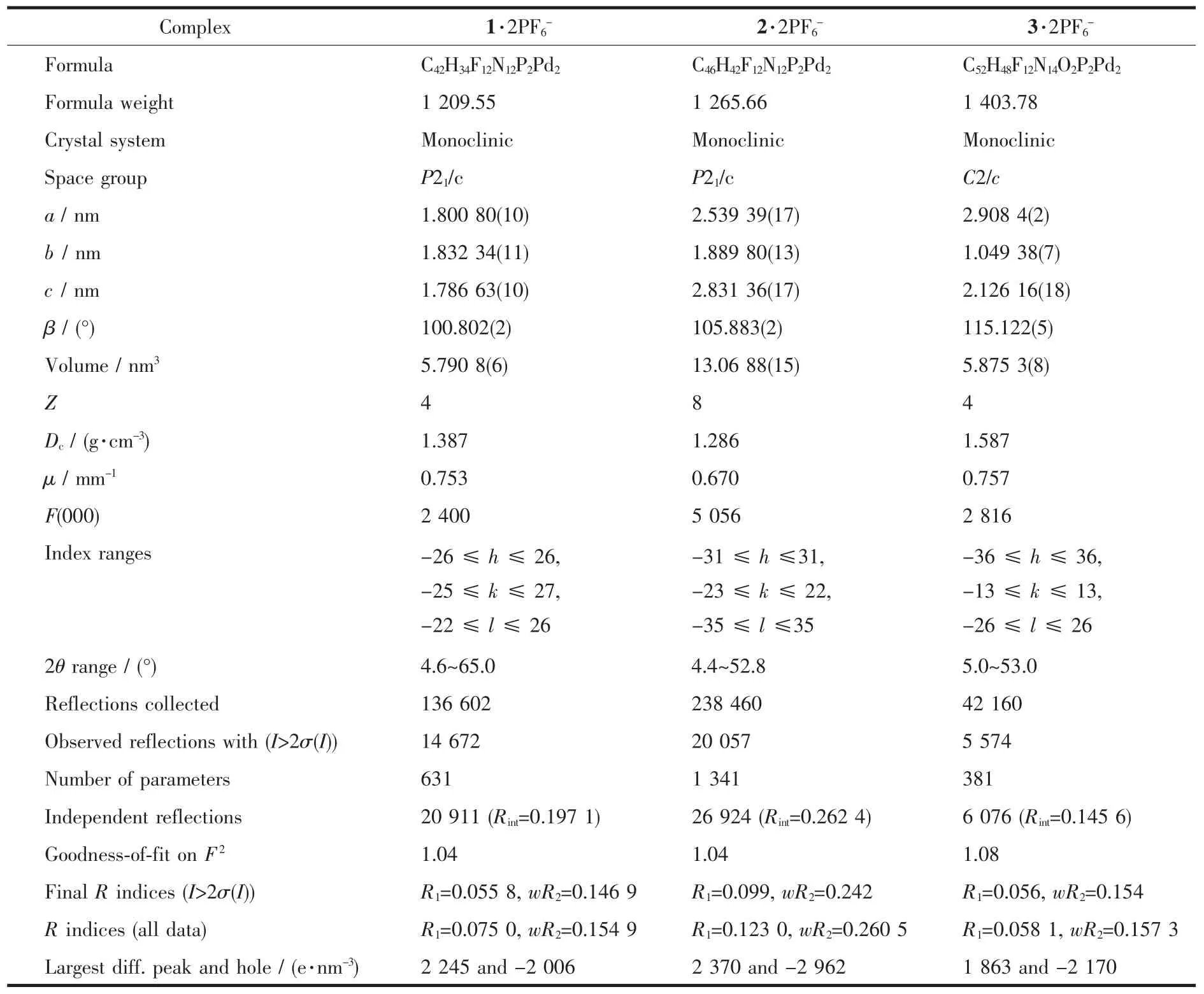Pyrazolate-Based Dipalladium(Ⅱ,Ⅱ)Complexes:Syntheses,Characterization and Catalytical Performance in Suzuki-Coupling Reaction
CHEN HanYU Zhi-ChunDENG WeiJIANG Xuan-Feng*,YU Shu-Yan*,,
(1Laboratory for Self-Assembly Chemistry,Department of Chemistry,Renmin University of China,Beijing 100872,China) (2Beijing Key Laboratory for Green Catalysis and Separation,Department of Chemistry and Chemical Industry, College of Environmental and Energy Engineering,Beijing University of Technology,Beijing 100124,China)
Pyrazolate-Based Dipalladium(Ⅱ,Ⅱ)Complexes:Syntheses,Characterization and Catalytical Performance in Suzuki-Coupling Reaction
CHEN Han1YU Zhi-Chun2DENG Wei1JIANG Xuan-Feng*,2YU Shu-Yan*,1,2
(1Laboratory for Self-Assembly Chemistry,Department of Chemistry,Renmin University of China,Beijing 100872,China) (2Beijing Key Laboratory for Green Catalysis and Separation,Department of Chemistry and Chemical Industry, College of Environmental and Energy Engineering,Beijing University of Technology,Beijing 100124,China)
A series of pyrazolate-based dipalladium(Ⅱ,Ⅱ)complexes named[Pd2(bpy)2L2]2+(1),[Pd2(dmbpy)2L2]2+(2)and[Pd2(phen)2L2]2+(3)(bpy=2,2′-bipyridine,dmbpy=4,4′-dimethyl-2,2′-bipyridine.phen=1,10-phenanthroline) have been synthesized through a directed coordination approach that involves spontaneous deprotonation of the 1H-pyrazolyl ligands(HL)in aqueous solution driven by coordination effect.All of new complexes 1~3 have been fully characterized by1H NMR,13C NMR,ESI-MS and single-crystal X-ray diffraction analysis.A weak intramolecular Pd…Pd(0.303~0.313 nm)bonding interaction exist in the solid crystal structure,a 1D helical chain network formed by hydrogen bonds interactions between intermolecular,which can be employed as a new kind of high-efficiency catalysts for Suzuki-coupling reaction.CCDC:1519041,1·2PF6-;1536149,2·2PF6-; 1536150,3·2PF6-.
dipalladium(Ⅱ)clips;catalyst;Suzuki-coupling reaction
Pyrazolate-based complexes have caught a plenty of attention not only for their structural diversity,such as clusters[1-2],metallomacrocycles[3-7],metal-oraganic cages[8-9],but also for their physico-chemical properties[10-11]and potential application in the field of organocatalysis,biological mimicry,magnetic coupling, electron transfer,opto-electronicmaterials,etc[12].In our group,we have reported a series of mutifunctional pyrazole-based ligands using as linker and corresponding well-defined metallosupramolecular quantitatively assembled via coordination reaction between pyrazolate linker and dimetal corners[M2(bpy)2(NO3)2] (NO3)2or[M2(phen)2(NO3)2](NO3)2(M=Pd)[8-9].
Meanwhile,thetransitionmetalpalladium complexes have been a hot topic in the area of Suzuki-coupling reaction.Especially,the mononuclear palladium catalysis had played a crucial role in syntheticorganicchemistryforSuzuki-coupling reaction.Although mononuclear palladium catalysis has historically dominated the field,the explorations of Pd…Pd bond-containing complexes′using as catalysts for Suzuki-coupling reaction,are fleetly in progressandbecomepopularforitsunique advantages[13-15].
Based on the numerous advantages of pyrazolatebased complexes and the promising catalyst activity of Pd…Pd bond-containing complexes,it is necessary to studythecatalyticactivityofpyrazolate-based dipalladium(Ⅱ)complexes with weak intramolecular Pd…Pdbondinginteraction,asanimportantand fascinating subclass of palladium coordination.
Herein,we design the solution synthesis of the pyrazolyl ligand HL[16-17](Scheme 1)and dipalladium (Ⅱ,Ⅱ)clips to get three new Pd…Pd bond-containing clips(Scheme 2),which have been developed and applied into Suzuki-coupling reactions.Excitedly,we find that the Pd…Pd bond-containing clips whose anion have been changed into PF6-show good catalysis properties for Suzuki-coupling reaction although the Pd(Ⅱ)has been coordinated by four inactive N atoms. In addition,all of the complexes have been intensively studied by NMR,ESI-MS,and X-Ray single-crystal diffraction analysis.Interestingly,X-Ray single-crystal diffraction analysis reveals charming structures that the clips not only have weak intramolecular Pd…Pd bonding interaction,but also have chiral axis and F…H hydrogen bond.
1 Experimental
1.1 Materials and instruments
All reagents for synthesis and analysis were obtained commercially with analytical grade and used without further purification and was carried out in the laboratoryatmosphereunlessreportedotherwise. [Pd2(bpy)2L2](PF6)2(1·2PF6-),[Pd2(dmbpy)2L2](PF6)2(2· 2PF6-),[Pd2(phen)2L2](PF6)2(3·2PF6-)were prepared according to the literature procedures[18].

Scheme 1Synthesis route of ligand HL

Scheme 2Synthesis of organometallic“molecular clip”
1H and13C NMR spectra were recorded onBruker AV 400 MHz spectrometers.ESI-MS spectra were recorded on Octant TOF LC-plus 4G mass spectrometer.
1.2 Synthesis and characterization of 1·,2·
1.2.1 General pyrazole ligand preparation
The pyrazole ligand,3,5-di(2-pyrrolyl)-pyrazole (HL),was synthesized according to a reported procedure (referring to supporting information for the synthesis).1H NMR(400 MHz,DMSO-d6,298 K,TMS):δ 12.65 (s,1H),11.23(s,1H),11.12(s,1H),6.85(s,1H),6.71 (s,1H),6.55(s,1H),6.48(s,1H),6.28(s,1H),6.11 (s,1H),6.05(d,J=3.0 Hz,1H)(Fig.S1).
1.2.2 Synthesis and characterization of[Pd2(N^N)2L2]2+-type dimetallo-clips
The self-assembly of bipyrazolate-bridged metallo -clip complex 1·was shown in Scheme 2.A mixtureof[Pd2(bpy)2(NO3)2](NO3)2(19.3 mg,0.025 mmol)with HL(9.9 mg,0.05 mmol)in water resulted in the formation of 1·2NO3-in quantitative yield.A ten-fold excess of KPF6was added to the solution to give 1·as yellow solid(28.7 mg,Yield 95%).1H NMR(400 MHz,DMSO-d6,298 K,TMS):δ 11.36 (s,4H),8.64(s,4H),8.32(s,4H),7.98(s,4H),7.55(s, 4H),7.20(s,4H),6.88(d,J=16.8 Hz,6H),5.99(s,4H).13C NMR(400 MHz,DMSO-d6,298K,TMS):δ 156.99, 150.88,147.14,142.71,128.22,124.89,122.49,120.56, 109.31,108.04.Elemental analysis calculated for C42H34F12N12P2Pd2(%):C:41.71;H:2.83;N:13.90.Found(%): C:41.65;H:2.87;N:13.84.ESI-MS(CH3CN,m/z): Calcd.for[1·]+1 064.86,Found 1 064.86;[1]2+459.95,Found 459.95(Fig.S2~S4).
The same procedure as employed for 2·2PF6-was followed except that[Pd2(dmbpy)2(NO3)2](NO3)2(20.7 mg,0.025 mmol)was used as the starting material to give 2·2PF6-as yellow solid(30.3 mg,Yield 96%).1H NMR(400 MHz,DMSO-d6,298 K,TMS):δ 11.34 (s,4H),8.52(s,4H),7.82(d,J=6.0 Hz,4H),7.39(d,J= 6.0 Hz,4H),7.17(s,4H),6.88(s,2H),6.86(s,4H), 6.00(q,J=2.7 Hz,4H),1.06(s,12H).13C NMR(400 MHz,DMSO-d6,298K,TMS):δ 156.27,155.16,150.11, 147.09,128.62,125.47,122.59,120.52,109.30, 107.92,21.45.Elementalanalysiscalculatedfor C46H42F12N12P2Pd2(%):C:43.65;H:3.34;N:13.28. Found(%):C:43.58;H:3.42;N:13.11.ESI-MS(CH3CN, m/z):Calcd.for[2·PF6-]+1 121.14;Found 1 120.96; [2]2+488.07,Found 488.00(Fig.S5~S7).
The same procedure as employed for 3·2was followed except that[Pd2(phen)2(NO3)2](NO3)2(20.5 mg, 0.025 mmol)was used as the starting material to give 3·2PF6-as yellow solid(28.9 mg,Yield 92%).1H NMR (400 MHz,DMSO-d6,298 K,TMS):δ 11.43(d,J=2.9 Hz, 4H),8.92(dd,J=8.3,1.3 Hz,4H),8.36(dd,J=5.4,1.3 Hz,4H),8.25(s,4H),7.88(dd,J=8.3,5.4 Hz,4H),7.28 (ddd,J=3.9,2.6,1.5 Hz,4H),7.03(s,2H),6.88(td,J= 2.7,1.4 Hz,4H),5.94(dt,J=3.6,2.4 Hz,4H).13C NMR (400 MHz,DMSO-d6,298 K,TMS):δ 151.78,147.48, 141.53,131.00,128.18,126.69,122.59,120.61,109.33, 108.34,102.33.Elemental analysis calculated for C52H48F12N14O2P2Pd2(%):C:44.49;H:3.45;N:13.97. Found(%):C:44.37;H:3.52;N:13.83.ESI-MS(CH3CN, m/z):Calcd.for[3·]+1 112.08;Found 1 112.87;[3]2+483.05,Found 482.96(Fig.S8~S10).
1.3 X-ray crystallography of complex 1·,2·and 3·
The intensity data collections for 1·~3·(Crystal size/mm:0.10×0.11×0.15 for complex 1·;0.12×0.18×0.23 for complex 2·;0.11× 0.15×0.23 for complex 3·2)were performed on the Bruker Smart APEXⅡCCD diffractometer equipped with graphite monochromated Mo Kα radiation(λ= 0.071 073 nm)at(150±2)K.The empirical absorption correctionswereappliedbyusingtheSADABS program[19].The structures were solved by direct methods and refined by full matrix least-squares fitting on F2by SHELXTL-2014[20].All non-hydrogen atoms were refined anisotropically.The hydrogen atoms of organic ligands were located geometrically and fixed isotropic thermal parameters.Hydrogen atoms were included in idealizedpositionswithisotropicdisplacement parameters constrained to 1.5 times the Ueqof their attached carbon atoms for methyl hydrogens,and 1.2 times the Ueqof their attached carbon atoms for all others.SQUEEZE option was used for the final refinement in order to treat the disordered counter anions and solvent molecules.
The details of data with unit cell,space group, data collection,and refinement parameters are presented in Table 1 and Table S1~S3.
1.4 Catalytic activity test
To explore the catalyst activity of pyrazolatebased dipalladium(Ⅱ)complexes with weak intramolecular Pd…Pd bonding interaction,different reaction conditions have been tried to obtain the feasible solution.

Scheme 3Catalytic activity of Suzuki cross-coupling reactions
Table 1Crystal structure determination data for complexes 1·,2·and 3·

Table 1Crystal structure determination data for complexes 1·,2·and 3·
?Complex1·2PF6-2·2PF6-3·2PF6-FormulaC42H34F12N12P2Pd2C46H42F12N12P2Pd2C52H48F12N14O2P2Pd2Formula weight1 209.551 265.661 403.78 Crystal systemMonoclinicMonoclinicMonoclinic Space groupP21/cP21/cC2/c a/nm1.800 80(10)2.539 39(17)2.908 4(2) b/nm1.832 34(11)1.889 80(13)1.049 38(7) c/nm1.786 63(10)2.831 36(17)2.126 16(18) β/(°)100.802(2)105.883(2)115.122(5) Volume/nm35.790 8(6)13.06 88(15)5.875 3(8) Z 4 8 4 Dc/(g·cm-3)1.3871.2861.587 μ/mm-10.7530.6700.757 F(000)2 4005 0562 816 Index ranges-26≤h≤26,-31≤h≤31,-36≤h≤36, -25≤k≤27,-23≤k≤22,-13≤k≤13, -22≤l≤26-35≤l≤35-26≤l≤26 2θ range/(°)4.6~65.04.4~52.85.0~53.0 Reflections collected136 602238 46042 160 Observed reflections with(I>2σ(I))14 67220 0575 574 Number of parameters6311 341381 Independent reflections20 911(Rint=0.197 1)26 924(Rint=0.262 4)6 076(Rint=0.145 6) Goodness-of-fit on F21.041.041.08 Final R indices(I>2σ(I))R1=0.055 8,wR2=0.146 9R1=0.099,wR2=0.242R1=0.056,wR2=0.154 R indices(all data)R1=0.075 0,wR2=0.154 9R1=0.123 0,wR2=0.260 5R1=0.058 1,wR2=0.157 3 Largest diff.peak and hole/(e·nm-3)2 245 and-2 0062 370 and-2 9621 863 and-2 170
In a typical experiment,the iodobenzene(204 mg,1 mmol),benzeneboronic acid(136 mg,1 mmol) and K3PO4(636 mg,3 mmol),1·2PF6-(12 mg,10 μmol)or 2·(12 mg,10 μmol)or 3·(12 mg,10 μmol))was added into a 250 mL two-necked flask.Under argon atmosphere,1,4-dioxane(100 mL) was added,and the suspension was stirred at 100℃. After the reactant disappeared(2 days,monitored the consumption of the starting iodobenzene by TLC),the mixture was cooled to room temperature.The reaction mixture was directly filtered and dried to get crude product(90%purity),than through column chromatograph eluting with hexane to give the expected compound(141 mg,Yield 88%)as a white solid.1H NMR (400 MHz,chloroform-d,298 K,TMS):δ 7.57(d,J= 7.3 Hz,2H),7.49(d,J=8.0 Hz,2H),7.42(t,J=7.6 Hz, 2H),7.32(t,J=7.3 Hz,1H),7.27~7.23(m,2H),2.39 (s,3H).
2 Results and discussion
2.1 Characterization of[Pd2(N^N)2L2]2+-type dimetallo-clips
2.2 Crystal structures of the dimetallo-clips

Fig.1ORTEP diagram of the molecular structure of

Fig.2(a)1D helix chain along b axis;(b)Crystal packing as seen along c axis
2.3 Catalytic activity
Wewerepleasedtofindthatthereaction proceeded smoothly in refluxing 1,4-dioxane for 48 h to provide product biphenyl in good yields(Table 2). But it could not be further improved as increasing the ratio of 1·2PF6-(2·2PF6-,or 3·2PF6-).
动物性食品在贮藏过程中由于微生物和酶的作用,蛋白质被分解而产生氮及胺类等碱性含氮物质,通过测定TVB-N值,即可判定肉的新鲜程度[4]:TVB-N≤15mg/100g为新鲜肉(一级鲜度);15mg/100g
With the optimal reaction conditions(1∶1 of nA∶nB,K3PO4,1%(n/n)catalyst,1,4-dioxane,at 90℃)in hand,the reactions of A with various boric acid derivatives were explored to gauge the generality of this process(Table 3).For the substrates bearing electrondonating(-OMe,-CH3)and electron-withdrawing groups (-CHO)on the phenyl ring(R1,R2),the reactions proceeded smoothly to give the corresponding biphenyl compounds C1in 78%~88%yields,C2in 60%~78% yields,C3in 56%~76%yields.In addition,electrondonating(-OMe,-CH3)boric acids tend to have higher yields than electron-withdrawing groups(-CHO)boric acids during the reactions.The reasons of the difference yields of C1(C2,or C3)may be the different steric effect of 1·2PF6-(2·2PF6-or 3·2PF6-)during the reactions.

Scheme 4
Table 2Catalytic activity of complexes,and

Table 2Catalytic activity of complexes,and
EntryCatalystCo-catalystSolventT/℃Time/hYield/% 1 1·2PF6-K3PO41,4-dioxane904895 2 2·2PF6-K3PO41,4-dioxane904893 3 3·2PF6-K3PO41,4-dioxane904888
Table 3Catalytic activity of complexesand

Table 3Catalytic activity of complexesand
EntryCatalystR1R2ProductYield/% 1 1·2PF6-CH3HC188 2 OMeOMeC278 3 CHOHC376 4 2·2PF6-CH3HC185 5 OMeOMeC274 6 CHOHC370 7 3·2PF6-CH3HC178 8 OMeOMeC260 9 CHOHC356
3 Conclusions
In summary,of three Pd…Pd bond-containing complexes are synthesized via a directed coordination driving approach that occurs along with spontaneous deprotonation of the ligand and three organometallic“molecular clips”(M2L2)are generated in nearly quantitativeyield.Allofthestructuresare characterized by1H NMR,13C NMR,ESI-MS,and single-crystalX-raydiffractionanalysis.More interestingly,pyrazolate-based dipalladium(Ⅱ)clips with weak intra-molecular Pd…Pd bonding interaction which are coordinated by four inactive N atoms exhibit good catalytic activity for Suzuki-coupling reaction.
Acknowledgments:This project was supported by the National Natural Science Foundation of China(No.91127039, 21471011)and the Importation and Development of High-Caliber Talents Project of Beijing Municipal Institution.Supporting information is available at http://www.wjhxxb.cn
[1]Ahmed B M,Gellert M.Inorg.Chem.,2016,55:7717-7728
[2]Nicola C D,Garau F,Gazzano M,et al.Cryst.Growth Des., 2015,15:1259-1272
[3]Yu S Y,Huang H P,Li S H,et al.Inorg.Chem.,2005,44: 9471-9488
[4]Ning G H,Yao L Y,Liu L X,et al.Inorg.Chem.,2010,49: 7783-7792
[5]Ning G H,Xie T Z,Pan Y J,et al.Dalton Trans.,2010,39: 3203-3211
[6]Xie T Z,Guo C,Yu S Y,et al.Angew.Chem.Int.Ed.,2012, 51:1177-1181
[7]Tong J,Yu S Y,Li H.Chem.Commun.,2012,48:5343-5345
[8]Yu S Y,Jiao Q,Li S H,et al.Org.Lett.,2007,9:1379-1382
[9]Jiang X F,Deng W,Jin R,et al.Dalton Trans.,2014,43: 16015-16024
[10]Fujisawa K,Ishikawa Y,Miyashita Y,et al.Inorg.Chim. Acta,2010,363:2977-2989
[11]Sun Q F,Liu L X,Huang H P,et al.Inorg.Chem.,2008, 47:2142-2154
[12]La Monica G,Ardizzoia G A.Progress in Inorganic Chemistry: Vol.46.Karlin K D.Ed.New York:Wiley,1997:151-238
[13]Ogura T,Yoshida K,Yanagisawa A,et al.Org.Lett.,2009, 11:2245-2248
[14]Baya M,Houghton J,Konya D,et al.J.Am.Chem.Soc., 2008,130:10612-10624
[15]Oldenhof S,Lutz M,Bruin B,et al.Organometallics,2014, 33:7293-7298
[16]Hassner A,Fogler E.Heterocycles,2009,77:301-309
[17]Huang H P,Li S H,Yu S Y,et al.Inorg.Chem.Commun., 2005,8:656-660
[18]HU Jia-Hua(胡佳华),DENG Wei(邓威),JIANG Xuan-Feng (蒋选丰),et al.Chinese J.Inorg.Chem.(无机化学学报), 2015,31:1278-1286
[19]Sheldrick G M.SADABS,University of Göttingen,Germany, 1996.
[20]Sheldrick G M.SHELXTL-2014,Madison,Wisconsin,USA: Siemens Analytical X-ray Division,2014.
吡唑双钯(Ⅱ,Ⅱ)配合物的合成与表征及其在Suzuki偶联反应中的催化反应
陈涵1于智淳2邓威1蒋选丰*,2于澍燕*,1,2
(1中国人民大学化学系,自组装化学实验室,北京100872) (2北京工业大学环境与能源工程学院,绿色催化与分离北京市重点实验室,北京100124)
配体3,5-二(2-吡咯)吡唑(HL)与二硝酸根桥联双钯配合物在溶液中通过配位作用形成了一系列吡唑基双钯(Ⅱ,Ⅱ)夹子[Pd2(bpy)2L2]2+(1)、[Pd2(dmbpy)2L2]2+(2)和[Pd2(phen)2L2]2+(3)(bpy=2,2′-联吡啶,dmbpy=4,4′-二甲基-2,2′-联吡啶,phen=1,10-菲咯啉)。运用1H NMR、13C NMR、ESI-MS和X射线单晶衍射等测试手段对1~3的结构进行了表征。其晶体结构中存在弱的Pd…Pd键(0.303~0.313 nm)相互作用,通过分子间的氢键作用形成一维二重螺旋结构,可作为一种新颖的Suzuki-coupling反应的高效催化剂。
双钯(Ⅱ)夹子;催化;Suzuki偶联反应
O614.82+3
A
1001-4861(2017)06-0939-08
2016-12-24。收修改稿日期:2017-03-13。
10.11862/CJIC.2017.090
国家自然科学基金(No.21471011)和北京市高层次人才引进项目资助。
*通信联系人。E-mail:yusy@ruc.edu.cn,jxf19821023@bjut.edu.cn

